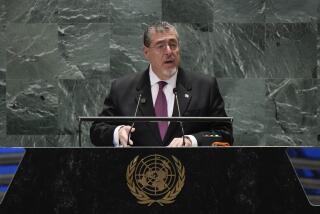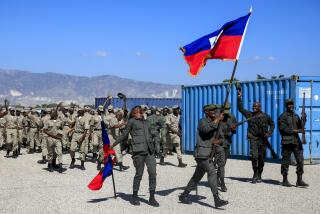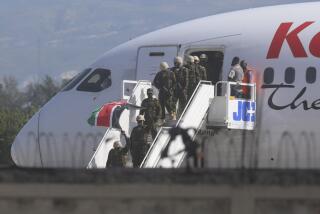U.S. Military Will Shelter Haitians at Base in Cuba
WASHINGTON — The Defense Department began mobilizing hundreds of medical professionals, military police and refugee experts Monday for deployment to Guantanamo Bay, Cuba, where they are to assume a vastly expanded role in the care and feeding of thousands of Haitians fleeing their country’s new military government, defense officials said.
Responding to the growing flood of Haitian refugees, and to a Florida judge’s decision prohibiting the United States from turning them back, Gen. Colin L. Powell on Monday ordered the military to prepare shelters, sanitary facilities and medical care for thousands of Haitians.
But even as Powell, chairman of the Joint Chiefs of Staff, established a military task force to coordinate the Pentagon’s response to the refugee crisis, defense officials fretted that the military’s growing role could cause a new wave of Haitian refugees.
“You’ve got a potential for a Mariel boat lift operation, once the Haitians hear that they’ll be taken care of as soon as they get into international waters,” said one defense official. “Once it starts, we’re all concerned--the Justice Department, too--with how many will come out and whether we’ll have the facilities and care they’ll need.”
In 1980, the Mariel boat lift brought more than 118,000 Cubans to the United States in a three-month period after Cuba’s President Fidel Castro briefly allowed Cubans to emigrate. The sudden influx of refugees, most of them poor and some with criminal records, strained U.S. local, state and federal governments called upon to absorb them.
While defense officials widely view their new role as a headache, few were surprised that the White House turned for assistance to the Pentagon, which operates dozens of ships in the Caribbean and maintains several bases in the region.
The joint-service military task force, commanded by Marine Corps Brig. Gen. George H. Walls Jr., is expected to draw service personnel mainly from East Coast bases. Walls is the commanding general of the Second Force Service Support Group, based at Camp Lejeune, N.C.
A defense official said that 100 medical professionals were to leave their bases Monday night; the force dispatched to deal with Haitians in Guantanamo could expand quickly to 800 GIs.
Many of Guantanamo Bay’s 1,900 buildings, spread out across 31 square miles in the southeast corner of Cuba, will be equipped immediately to house between 2,500 and 3,000 Haitian refugees. Tents and other temporary shelters will be put up as needed, officials said.
A detention center designed expressly to hold those illegally entering the United States--and especially Haitians--would not be unprecedented. In response to the Mariel crisis in 1980, the Immigration and Naturalization Service opened an abandoned Nike missile defense base at the edge of the Everglades as a processing center. After the Mariel boat lift ended, the camp, called Krome Detention Center, remained, a permanent installation that at any given time is home to hundreds of foreign nationals.
Those held in the camp, surrounded by barbed wire, wear orange uniforms. They study English and sleep in huge dormitories. Over the years, tales of abuse of detainees at Krome have been common, and recent demands that the camp be shut have come from lawmakers, Amnesty International and a host of other human rights groups.
In the current exodus, Coast Guard and Navy ships already have taken about 3,200 Haitians aboard, and observers said there is no end in sight. Over the weekend, 1,197 Haitians were plucked from overloaded sailboats, joining about 2,000 others being held on the decks of U.S. Coast Guard cutters, on at least two U.S. Navy ships and at Guantanamo Naval Base.
While the military has not chosen further sites to house refugees, officials said more bases and military personnel could be mobilized if greater numbers of Haitians take to the open seas.
The Pentagon’s expanded role in support of an overwhelmed Coast Guard follows a weekend of intense discussions between Justice Department attorneys and lawyers representing the Haitian exiles.
Cheryl Little, attorney for Miami’s Haitian Refugee Center, said Monday of the Pentagon’s plan: “It’s positive in that the Haitians will no longer be in floating detention facilities, and the Coast Guard can conduct search and rescue. But I have reservations with respect to what’s going to happen next. Are we setting up camps for black people again?”
She was referring to the Krome Detention Center, where Haitians generally make up the bulk of the population.
A lawsuit filed by Little last Tuesday led to a federal judge’s order halting forced repatriation of Haitians. That order will remain in effect at least until next Tuesday.
But the order by U.S. District Judge Donald L. Graham does not prevent refugees from being sent to third countries, nor does it resolve concerns over the fairness of shipboard interviews in which immigration officials determine which Haitians may have a legitimate claim to political asylum.
President Bush has defended his Administration’s initial decision to send the Haitians back to their impoverished homeland, calling them economic, rather than political, refugees. Allowing the Haitians in, Bush said, would constitute “a policy that acts as a magnet to risk these people’s lives.”
Of the 4,548 Haitians plucked from often-unseaworthy boats since Oct. 29, only about 85 have been permitted to go to Miami to pursue asylum claims. The others are either under the care of U.S. forces, were returned to Haiti before the federal order or have found refuge elsewhere.
But human rights groups and many U.S. lawmakers have contended that thousands of Haitians must have legitimate fears of persecution in a country still in turmoil as a result of the Sept. 30 coup that ousted President Jean-Bertrand Aristide.
Seven Coast Guard cutters and the amphibious ship Tortuga are at anchor in Guantanamo Bay, where they are serving as temporary homes for the refugees, according to Petty Officer Joe Dye. At least nine other ships are patrolling the Windward Passage, between Haiti and Cuba, to interdict Haitian craft there; at least six other Coast Guard cutters are en route to the area from U.S. ports, Dye said.
“When these boats are full, what do we do then?” Dye asked. “This has put a strain on the Coast Guard and our mission to rescue people. We only have room for so many people.”
Times special correspondent Mike Clary, in Miami, contributed to this story.
More to Read
Sign up for Essential California
The most important California stories and recommendations in your inbox every morning.
You may occasionally receive promotional content from the Los Angeles Times.











